Figure 3.
Infusion of different doses of the DAG analogs DOG and OAG showed that both analogs affected different ion channels underlying the bombykal-dependent normalized sensillum potential amplitude (SPA) with different sensitivity. (A,B) 1, 100, and 200 μM of the DAG-analogs DOG and OAG were applied in tip recordings during the late activity phase (ZT 1). The overall values (A) as well as the percentage changes to the controls (B) show a significant decrease in the normalized SPA in the presence of 1 μM (n = 7) or 200 μM DOG (n = 5), while 100 μM DOG (n = 9) had no effect. Application of 1 μM OAG reduced the normalized SPA (n = 5), while 200 μM OAG (n = 5) moderately- and 100 μM OAG more strongly increased it (n = 6). (C) During rest (ZT 9) the mean values of the normalized SPA were significantly reduced by 1 μM DOG (n = 6) and significantly increased by application of 200 μM DOG (n = 7) and 100 μM OAG (n = 7). All other concentrations showed no significant differences from the controls in their mean values. (D) However, all concentrations applied showed significant differences in the percentage change from the control (for exact P-values see Table 2; for mean values ± SEM see S2. n.s. = not significant; *P < 0.05; **P < 0.01; ***P < 0.001; ****P < 0.0001; Wilcoxon test, Mann-Whitney test or Kruskal-Wallis test with Dunn's post-hoc test for multiple comparison).

